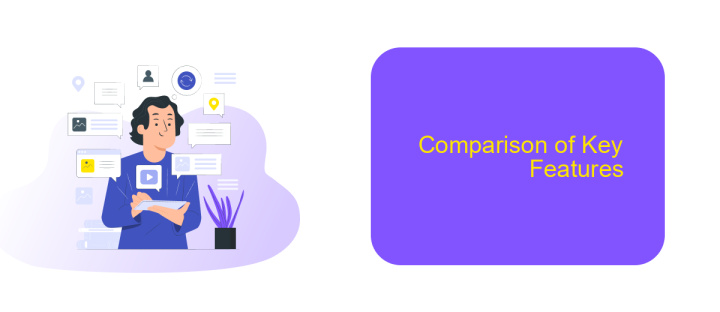Dreamfactory Vs MuleSoft
In today's rapidly evolving digital landscape, businesses are increasingly relying on robust API management solutions to streamline their operations and enhance connectivity. Dreamfactory and MuleSoft are two prominent players in this domain, each offering unique features and capabilities. This article delves into a comparative analysis of Dreamfactory and MuleSoft, exploring their strengths, weaknesses, and ideal use cases to help organizations make informed decisions.
Introduction
In today's fast-paced digital landscape, businesses are increasingly relying on integration platforms to streamline operations and enhance productivity. Dreamfactory and MuleSoft are two prominent players in this field, offering robust solutions for API management and integration. Understanding the key differences and strengths of each platform can help organizations make informed decisions that align with their specific needs.
- Dreamfactory: Known for its open-source nature and rapid API generation capabilities.
- MuleSoft: Renowned for its comprehensive integration suite and enterprise-level features.
- ApiX-Drive: A versatile tool that facilitates seamless integration processes with minimal effort.
Both Dreamfactory and MuleSoft offer unique advantages, whether it's Dreamfactory's ease of use or MuleSoft's extensive feature set. Additionally, tools like ApiX-Drive can complement these platforms by simplifying the integration process further. By evaluating these options, businesses can leverage the best tools to optimize their workflows and achieve greater efficiency.
Dreamfactory Platform Overview

DreamFactory is a robust platform designed to simplify API management and development. It offers a comprehensive suite of tools that enable developers to quickly generate, manage, and secure APIs from various data sources. With DreamFactory, users can connect to databases, file storage systems, and third-party services, all while leveraging built-in features such as user authentication, role-based access control, and detailed logging for enhanced security and monitoring.
One of the standout features of DreamFactory is its ability to streamline the integration process. By utilizing services like ApiX-Drive, users can easily set up and manage integrations between different software applications without extensive coding knowledge. This makes it an ideal solution for businesses looking to automate workflows and improve operational efficiency. DreamFactory's intuitive interface and powerful backend capabilities ensure that even complex integration scenarios can be handled with ease, providing a seamless experience for both developers and end-users.
MuleSoft Platform Overview

MuleSoft is a comprehensive integration platform that enables businesses to connect applications, data, and devices seamlessly. With its robust Anypoint Platform, users can design, build, and manage APIs and integrations with ease. MuleSoft supports a wide range of integration patterns, making it suitable for various use cases, from simple data migration to complex hybrid integration scenarios.
- Anypoint Design Center: Allows users to design and mock APIs and integrations quickly.
- Anypoint Exchange: A marketplace for connectors, templates, and APIs to accelerate development.
- Anypoint Management Center: Provides monitoring, analytics, and governance for APIs and integrations.
- API Gateway: Ensures security and scalability for API traffic.
- Connectors: Pre-built connectors to integrate with popular systems like Salesforce, SAP, and more.
With MuleSoft, organizations can achieve faster time-to-market and improved agility. Similar to services like ApiX-Drive, MuleSoft simplifies the integration process, allowing businesses to automate workflows and enhance productivity. The platform's extensive features and user-friendly interface make it a preferred choice for enterprises looking to streamline their integration efforts.
Comparison of Key Features

Dreamfactory and MuleSoft are both powerful integration platforms, but they cater to different needs and use cases. Dreamfactory is known for its ability to automatically generate APIs from various data sources, making it an excellent choice for developers seeking rapid API creation and deployment. MuleSoft, on the other hand, is renowned for its comprehensive integration capabilities, offering a robust solution for connecting a wide array of applications and services.
When comparing these platforms, it's important to consider their key features and how they align with your integration requirements. Both platforms offer unique strengths that can significantly impact your integration strategy.
- Dreamfactory: Automatic API generation, easy-to-use interface, strong support for RESTful APIs, and extensive data source connectors.
- MuleSoft: Comprehensive integration suite, strong enterprise-level capabilities, support for various protocols and data formats, and advanced analytics and monitoring tools.
- ApiX-Drive: User-friendly interface, quick setup, seamless integration with popular applications, and real-time data synchronization.
Choosing between Dreamfactory and MuleSoft depends largely on your specific needs and the complexity of your integration projects. While Dreamfactory excels in rapid API development, MuleSoft offers a more extensive set of tools for complex enterprise integrations. Additionally, ApiX-Drive can be a valuable tool for simplifying the integration process, offering a user-friendly platform for connecting multiple services efficiently.
Conclusion
In conclusion, both Dreamfactory and MuleSoft offer robust solutions for API management and integration, each catering to different needs and preferences. Dreamfactory stands out with its ease of use and rapid deployment capabilities, making it an excellent choice for small to medium-sized businesses looking for a cost-effective solution. On the other hand, MuleSoft excels in handling complex integrations and large-scale enterprise requirements, offering extensive features and support for various protocols and standards.
Ultimately, the choice between Dreamfactory and MuleSoft depends on your specific business needs, technical requirements, and budget. For those seeking a more straightforward and user-friendly approach to integration, Dreamfactory is a compelling option. However, if your organization demands a more comprehensive and scalable solution, MuleSoft is likely the better fit. Additionally, tools like ApiX-Drive can further simplify the integration process, providing seamless connectivity between various applications and services, thus enhancing the overall efficiency of your operations.


FAQ
What is the primary difference between Dreamfactory and MuleSoft?
Which platform is better for small to medium-sized businesses?
Can both Dreamfactory and MuleSoft be used for real-time data integration?
Do I need to have coding skills to use Dreamfactory or MuleSoft?
Are there alternative solutions for automating and configuring integrations without extensive technical knowledge?
Strive to take your business to the next level, achieve your goals faster and more efficiently? Apix-Drive is your reliable assistant for these tasks. An online service and application connector will help you automate key business processes and get rid of the routine. You and your employees will free up time for important core tasks. Try Apix-Drive features for free to see the effectiveness of the online connector for yourself.

